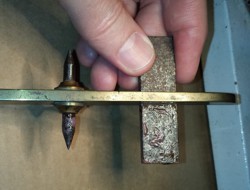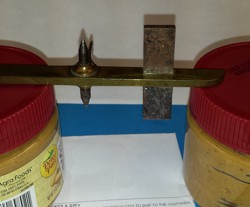De-Rusting Steel Parts
To get rid of the rust on steel screws and other parts, paint the parts with Naval Jelly Rust Dissolver. Leave the Naval Jelly on the part for half an hour or so, then rinse in water and scrub with a toothbrush. Then use your Dremel Tool with the 3/4" wire wheel and blast off the Iron Phosphate residue. If there is still rust on the part, you will have to repeat the procedure. Don't be surprised if you have to treat it several times. It all depends on how much rust is on the part.
Also, don't expect that leaving the Naval Jelly on the part for hours at a time will hasten the process. The chemical reaction is self-limiting. The active ingredient in Naval Jelly is Phosphoric Acid (which is also an ingrendient in Coca Cola!). It reacts with Iron Oxide to form Iron Phosphate and water. The problem is that the Iron Phosphate forms a barrier that stops the reaction after a time. So it's best to use several shorter applications rather than a longer application, as you will see no benefit from a prolonged exposure to the Naval Jelly.
For a really badly rusted part, you might also considering using Electrolysis to remove the rust. There are many websites that discuss the procedure, and even some YouTube videos showing how to do it.
**For special cases where you have a steel part physically attached to a brass piece, such as a telegraph key or sounder lever, where you have a steel pivot pin press-fit into the brass (sometimes the steel armature on old sounders or relays are also press-fit into the brass lever), you need to take extra care not to get any Naval Jelly on the brass or it will remove the existing patina.
So, working under your stereo microscope at 8x, use a small brush to paint the Naval Jelly onto the steel pivot pin and/or armature. Do this only on one side of the pivot pin. Don't try to do both sides at once. I'll explain this later. When you get close to the brass, put a small glob of Naval Jelly near the brass, then use the tip of the brush to push the Naval Jelly as close to the brass as possible, rather than trying to brush it. This will help prevent accidentally touching the brass with the brush.
After one side of the pivot pin or armature is coated, set the brass part on a stand with the pin/armature hanging downward. This prevents the Naval Jelly from running onto the brass. Let stand for 30 minutes, then rinse and scrub.
Now use your Dremel Tool with the wire wheel to blast off the residue. To protect the brass from the wire wheel, put small pieces of scotch tape on the brass in the area around the pin. Repeat the procedure as necessary until the rust is completely removed. When the first side is finished, repeat the same procedure on the opposite side.
If there is still any rust near the joint between the steel and brass, you can use your X-Acto knife to scrape it off (working under the microscope).
 |
 |
|---|---|
| An early relay lever with the armature and pivot pin painted with Naval Jelly | Hanging the part after treatment to avoid Naval Jelly running onto the brass |
After the rust has been removed from the part, you may want to consider applying a bluing chemical to the steel, especially if the part was originally blued. Bluing is quite often used as a finish on steel gun parts to protect them from rusting. Many early sounders and relays used bluing on the pivot pin and steel armature. Here is an example of an early Caton relay with blued steel parts.
To apply bluing, get a bottle of Perma-Blue from Birchwood Casey (see parts list on main restoration page). De-rust the part, then wipe the steel parts with a piece of paper towel soaked with Denatured Alcohol to remove any oil from the surface of the part. Dip a Q-Tip in the Perma-Blue and wipe it firmly on the steel part, making sure to cover every area. Use a tissue to soak up any extra chemical then let sit for about a minute. Now use a small ball of 0000 size Steel Wool to buff the part and give it a shine. Then rinse the part in the sink. Repeat the procedure if desired for a darker finish. Last, use a tissue with a drop of sewing machine oil and wipe it on the part. Use another dry tissue to clean up any excess oil.
**For bluing steel pivot pins and armatures, put pieces of scotch tape on the brass piece next to the steel to protect it from the bluing, because Perma-Blue will also turn brass blue !
